The advent of civilization is janus-faced. The first two primordial writing scripts derive from the same counting system. This system measured goods and services using little geometric clay tokens formed into spheres, cones, and tetrahedrons, shapes easily formed with three fingers. The tokens started to be used from around 7000bc, and seem to have symbolized quantity and object. So, ‘20 pigs’, instead of ‘20’ or ‘pigs’.
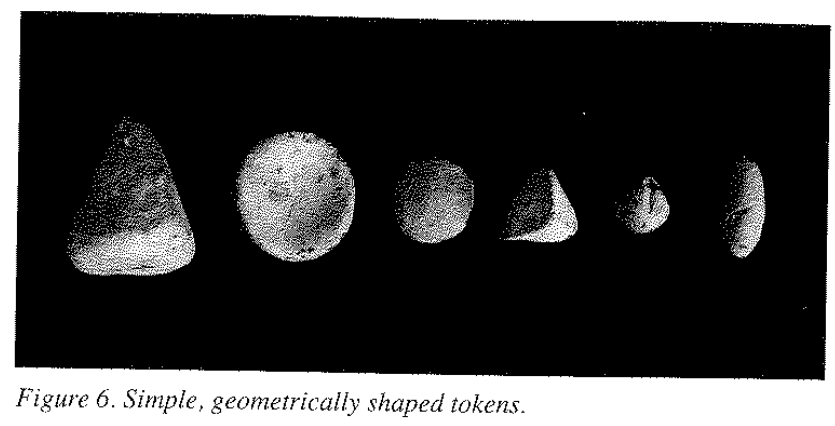
clay tokens
By around 4000bc the tokens started to be sealed inside of clay envelopes called bullae, which would be impressed by the cylinder seal of an administrative authority. The tokens then started to be impressed on the outside of their envelopes to mark their value externally, and soon it was realized this rendered the use of tokens redundant. So between 3500-3300bc these clay envelopes started to be flattened out and used as tablets, with impression of tokens upon them replaced by inscribed drawings of them, and these became the first symbols of the earliest known administrative texts from which writing derives.[0]

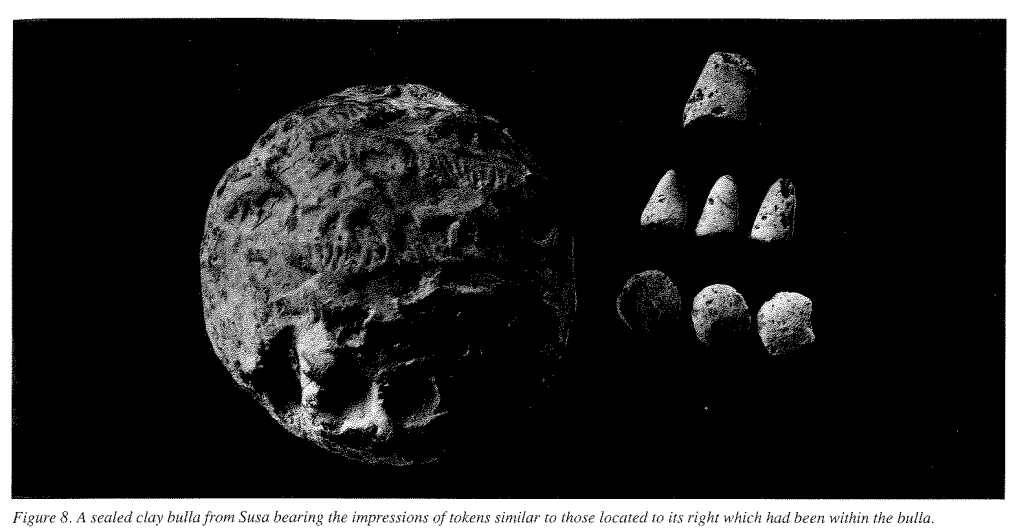
Archaic bookkeeping: early writing and techniques of economic administration in the ancient near east, Hans j nissen, Robert Englund, Peter Damerow, University of Chicago 1993
These geometric inscribed symbols evolved into separate pictograms and numerals, the pictograms(+) into logographic(‘cross’) arrays representing words for objects, which then allowed for the expression of metaphysical objects using words for concepts, all of which gave birth to the two earliest known protowriting scripts: protoCuneiform(pC) and protoElamite(pE).
This ability to express abstract metaphysical aspects of culture is why the definition of civilisation is defined as citylife + writing.[1] And this is why the advent of civilization is janus-faced. Because in this way two separate cities, Unug(Uruk) and Susun(Susa), of two separate cultures, Sumerian and Hatamti, developed two separate writing systems, protoCuneiform(pC) and protoElamite(pE), from the same set of geometric symbols, at the same time.
Ahhh, but you’ve never heard of an Hatamti(Elamite) civilisation, have you.
ProtoCuneiform is evidenced by symbols written on approx 4000 tablets from 9 sites across modern day Iraq, the oldest of which are dated to the carbon14 age of wood, 3300-3100bc, taken from the beam of a collapsed building within the Eanna temple district of the Sumerian city of Unug(Uruk),[2] where the vast majority of pC tablets have been found.
ProtoElamite is evidenced by symbols written on approx 1700 tablets from 8 sites across Iran, the oldest of which are dated to the carbon14 age of wood, 3300-3000bc, taken from the stratification layers of the Hatamti(Elamite) city of Anshan(Tal-I Malyan).[3] The vast majority of pE tablets are found in the Hatamti(Elamite) city of Susun(Susa).
Now, the reason you haven’t heard of Hatamti civilisation is because of a theory called ‘The Uruk Expansion’, described by its own proponents as ‘poorly understood’.[4]
“Proto-Elamite was invented in the wake of the Uruk expansion when lowland Mesopotamian culture was exported, in an as-of-yet poorly understood way, to northern Mesopotamia, Syria and Iran. As such, proto-Elamite is the only writing system, apart from proto-cuneiform of course, to emerge from the accounting techniques developed during the Uruk expansion period. It may, therefore, not be entirely correct to call proto-Elamite a loan from Mesopotamia, since it grew out of the same (Uruk-based and invented) system, which had spread to western Iran.”
- The Marks of Early Writing, Jacob Dahl, 2012
The theory is poorly understood because of its lack of evidence. Most of the evidence for the development of the counting system actually comes from artifacts found at archaeological sites in Iran during the 1960s and 1970s. These sites were shutdown in 1978 because of the Revolution, leaving an ancient history of early accounting systems to be produced from the avaliable evidence during the 1980s. After a decade of this scholarship accumulated on the archaeological evidence from Iran, kind of like a grime, it had become obscure enough to use for a ‘poorly understood’ theory attributing its origin to Uruk, which was then exalted by peer review through the 1990s into an academic consensus by the early 2000s, just in time for archaeological sites either side of Iran to be shutdown in Iraq and Afghanistan.
Into the 21st century this academic consensus has developed into a contested dialectic between an Oxford Assyriologist named Jacob Dahl, who upholds the Uruk Expansion thesis of pC supremacy over pE, steadily losing ground to its antithesis provided by an archaeologist named Francois Desset, who argues for parity between the pair as contemporaneous developments. The possibility pC is derived from pE is excluded.
Of the archaeological evidence from between 8000-3500bc, around 55 of 85 envelope/bullae artifacts come from sites in Iran associated with Hatamti(Elamite) culture:
Iran 55: Susun(52), Chongha Mish(2), Tepe Yahya(1)
Iraq 25: Unug(15), Umma(10)
Syria 3: Habubu Kabira(2), Dharan(1)
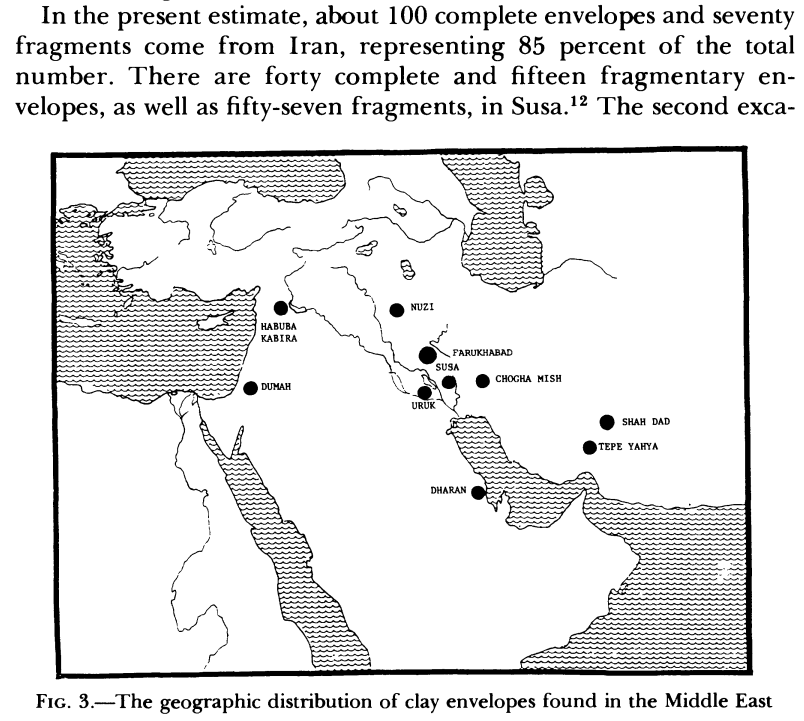
Of the archaeological evidence from between 3500-3300bc, around 86 of 166 tablet accounting artifacts come from sites in Iran associated with Hatamti culture:
Iran 86: Susan(49), Godin Tepe(39), Chongha Mish(8)
Iraq 62: Unug(59), Jemdet Nasr(2)
Syria 18: Habuba Kabira(3), Jebel Aruda(13), Nineveh(1), Mari(1)

In fact, the entire development of writing, from tokens to bullae balls to impressed envelopes to inscribed tablets to numeric tablets with pictograms to logographic writing, is evidenced chronologically in archaeological layers 20-16 of Acropolis I in Susun(Susa):[5]
Level 20-18(4000-3500bc): Bullae & Impressed Envelopes
Level 17(3500-3300bc): Impressed & Inscribed Numeric tablets
Level 16(3300-3000bc): ProtoElamite tablets
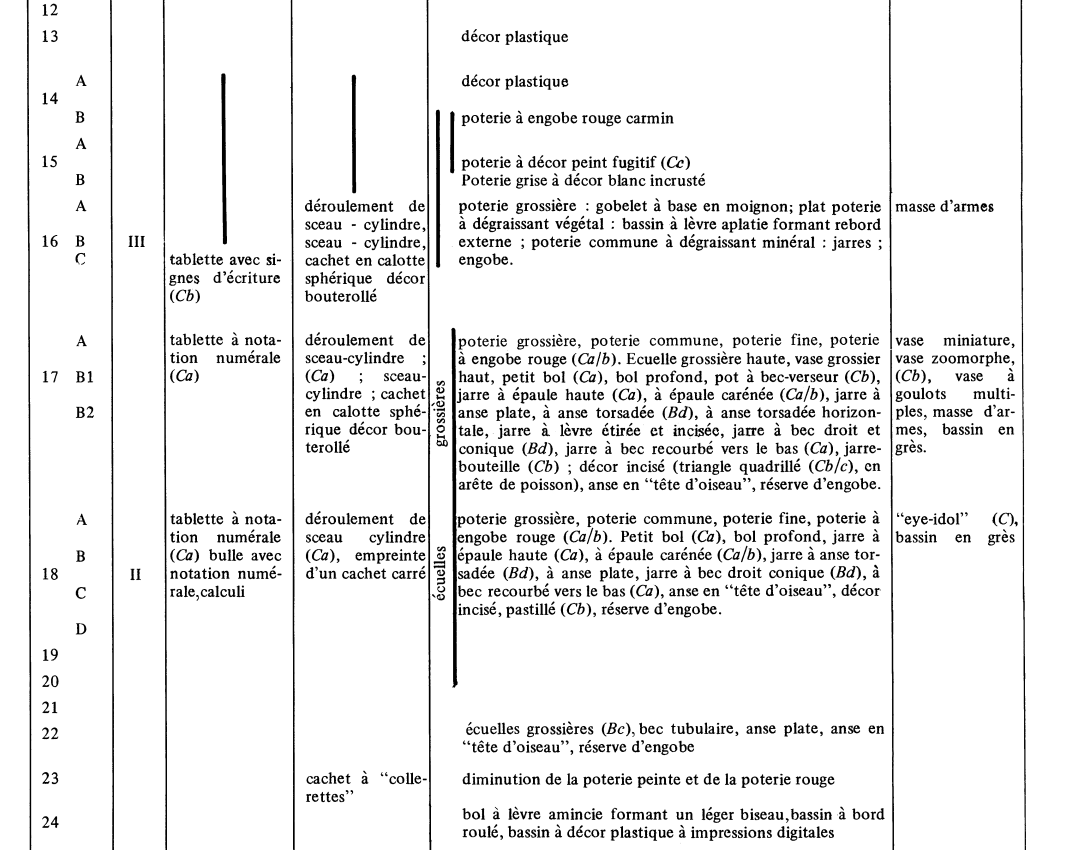
SUSE, CHANTIER "ACROPOLE 1", Alain LE BRUN, Source: Paléorient, Vol. 4 (1978), pp. 177-192
The dating for this can be confirmed by two external sources. The numeric tablets from Susun(Susa) level 17 match those discovered at a site in the Zagros mountains called Godin Tepe, dated to the same period 3500-3300bc. The pE texts at Susa level 16 match those from another ancient Hatamti city in central Iran called Anshan(Tall-i Malyan), which were carbon14 dated to between 3300-3000bc.[6]
At Unug(Uruk) the earliest pC tablets appear within an archaeological layer of the Eanna district dated to 3300bc. This date comes from seven pC tablets found sandwiched between the foundation and collapsed roof of a structure called the Red Temple. Wooden roof beams the tablets were found beneath carbon14 dated the temple’s construction to sometime between 3500-3300bc, thus entombing the tablets sometime between then and the temple’s collapse. However, the counting artifacts from Unug(Uruk) which antedate pC were discovered at the same layer, and thus outside of their native context. So technically speaking, the archaeological evidence for the development of writing appears spontaneously in Unug all at once around 3300bc.
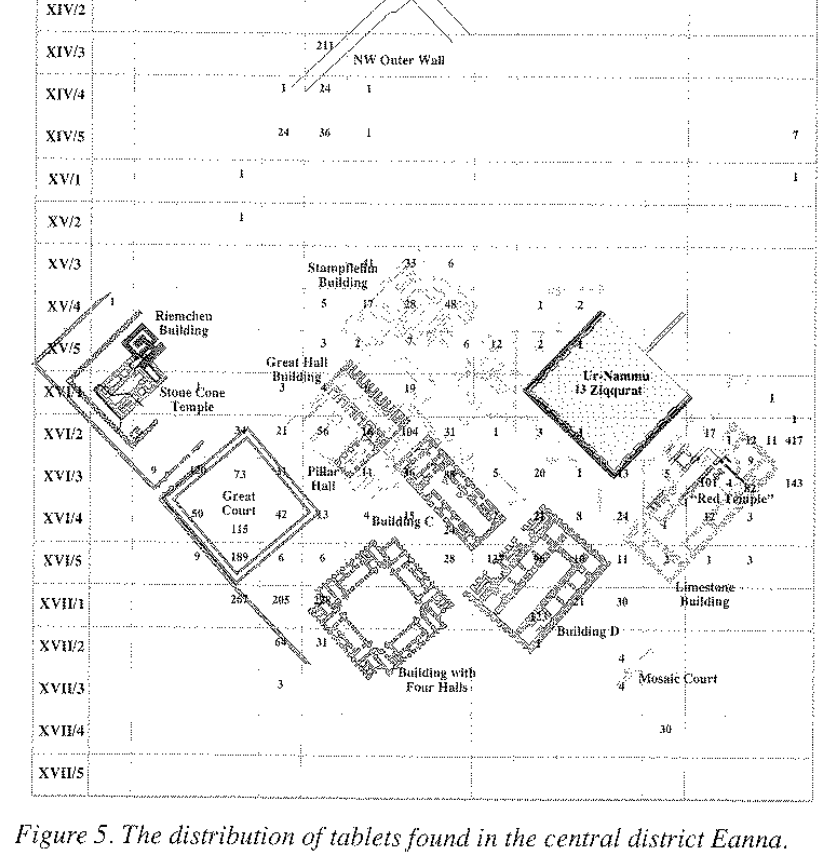
This meant any periodisation for writing based upon counting artifacts would have to use the Susun chronology. But this would lead the development of writing outside of Mesopotamia and into Hatamti territory. And since civilisation is defined by writing + citylife, Susun was a city, such a thing would also mean shifting the cradle of civilization from Sumerian to Hatamti.
So what they did is, use a mundane piece of pottery called a ‘beveled rim bowl’ as a derivative for dating counting artifacts, as this type of pottery could be found at the earliest layers of the Eanna district. This was done by pegging the pottery to counting artifacts through a theory which suggested beveled rim bowls had been used as a standardized unit of measure for voluming rations of grain or cereals, the bowls themselves being one of the very objects represented by a symbol in the counting system. Thus, shards of its presence should therefore equate to the presence of the counting system.[7]
If a piece of this ‘beveled rim bowl’ was found alongside a counting artifact at another site in Syria or Iran, this became evidence of Urukian cultural diffusion into that region, and the introduction into it of an Uruk invented counting system.
Once the underlying premise of this had been accepted, similarities between counting artifacts from Unug, and those found earlier at other sites, started to be used as evidence that all these counting systems came from Unug(Uruk), where the earliest shards of this pottery could be found at the bottom of a hole.
This is, quite obviously, utterly retarded. None the less, it was accepted as the academic consensus, which is to say, the academics who promoted this theory were promoted. Like how well-trained dogs will automatically sit for treats without having to be told. The treats in this case being grant money. The notable figure rewarded for this was Guillermo Algaze, who was given $500,000 by the MacArthur Fellowship in 2003 after coming up with his Uruk Expansion theory.
There's a major problem with this though. The counting artifacts from sites in Mesopotamia used a sexagesimal system, while artifacts from sites in Iran used this plus a decimal one. And while the Syrian sites in Mesopotamia followed the logical geographic expansion of Uruk trading posts up stream along the Euphrates river, the Iranian sites north of the Tigris river were entirely indicative of the Hatamti culture exemplified by Susun.
Let's cut the bullshit. Hatamti culture IS the true origin of sacred geometry.
This piece of painted pottery from Susun is dated 4000-3500bc. It has a four quartered square in the center and two 8x8 matrix chessboards with four swastika legs attached to each corner to express rotational motion.
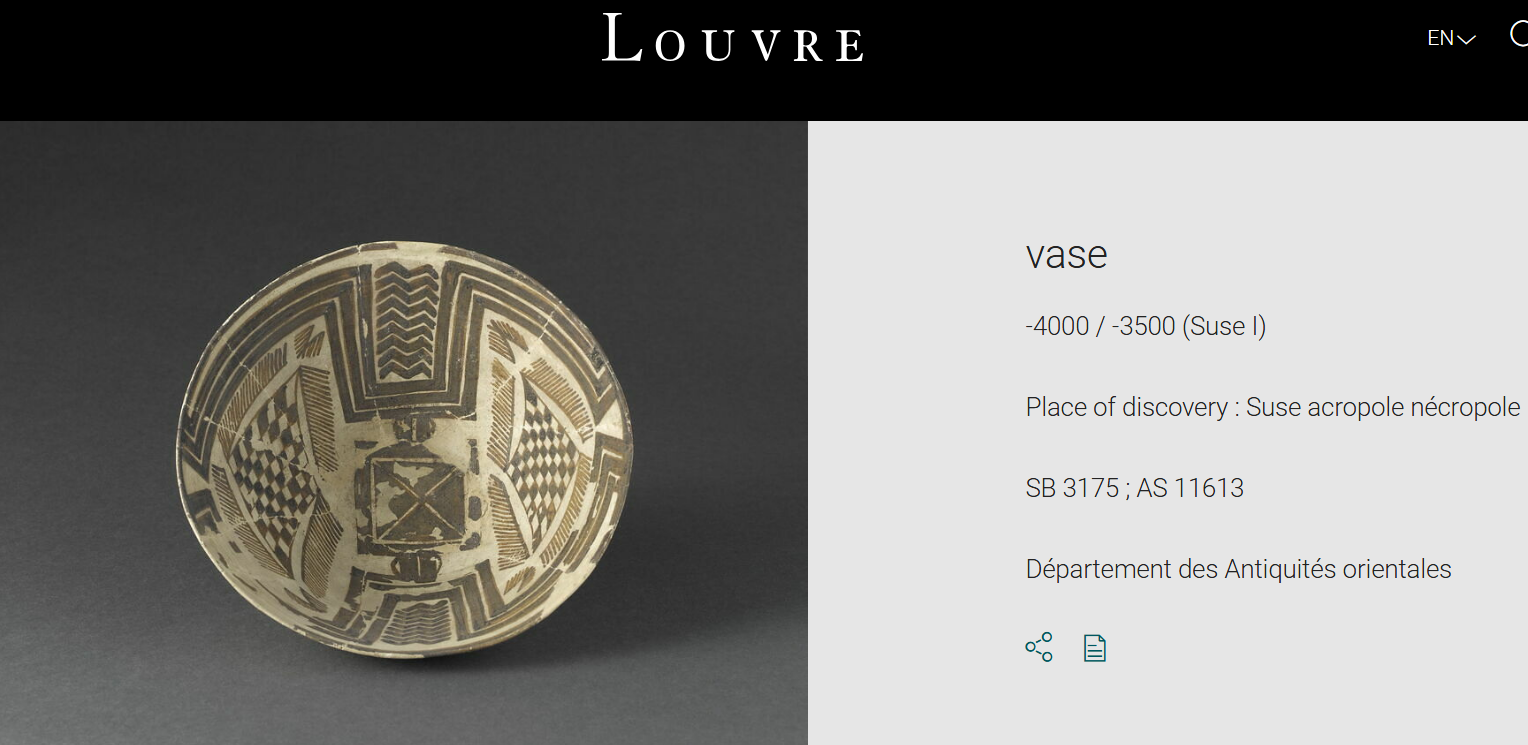
Mastergrid of the Mothertonuge, https://collections.louvre.fr/en/ark:/53355/cl010122794
This geometric chessboard pattern can be found all over Susun painted pottery, including a vase which seems to show the earliest known representation of the Caduceus symbol. Not just two snakes entwined vertically as a link between realms, but flanked either side by two mountain lions. A sophisticated representation of this exact motif is the one found over a thousand years later on the libation vase dedicated to ningishzida by the Lagashian ruler Gudea, who states he built the temple of ningirsu according to a sacred geometric design passed to him by the goddess Nisaba in a revelating dream or vision. All of which was covered in part 2 of this series.
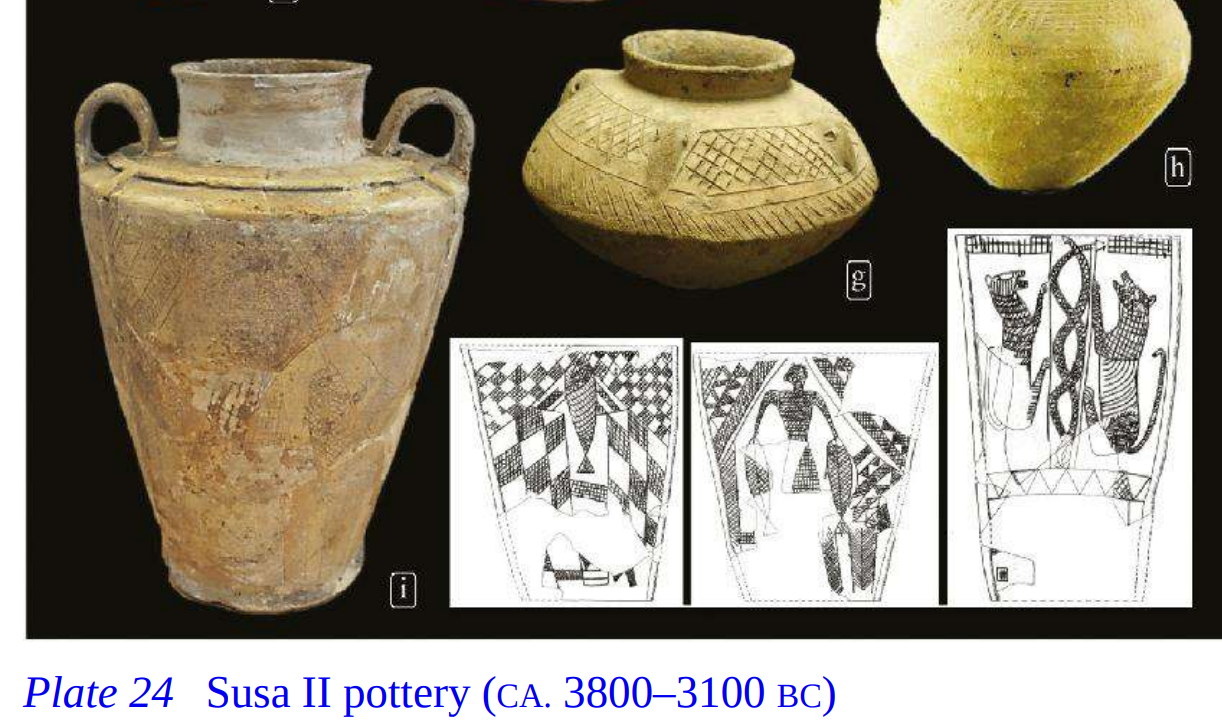
Art of Susa, Javier Álvarez-Mon, 2020, original source of find- LeBrun 1971, Pl. XXII:6

gudea caducaus. 2200-2100bc
Yet we are meant to believe shards of this shitty beveled rim bowl is evidence the counting system there came from Uruk.
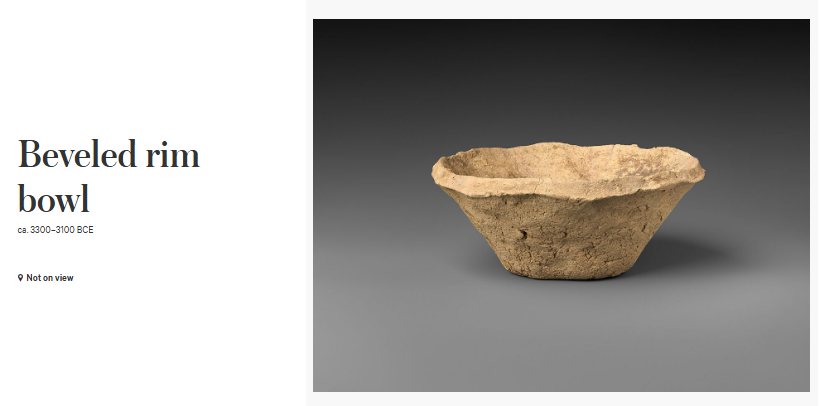
https://www.metmuseum.org/art/collection/search/325431
The earliest tablets which show evidence of geometric calculation come from Susun, dated between 3500-3300bc.

mdp 17264, 3500-3350 BC, https://cdli.mpiwg-berlin.mpg.de/artifacts/8560
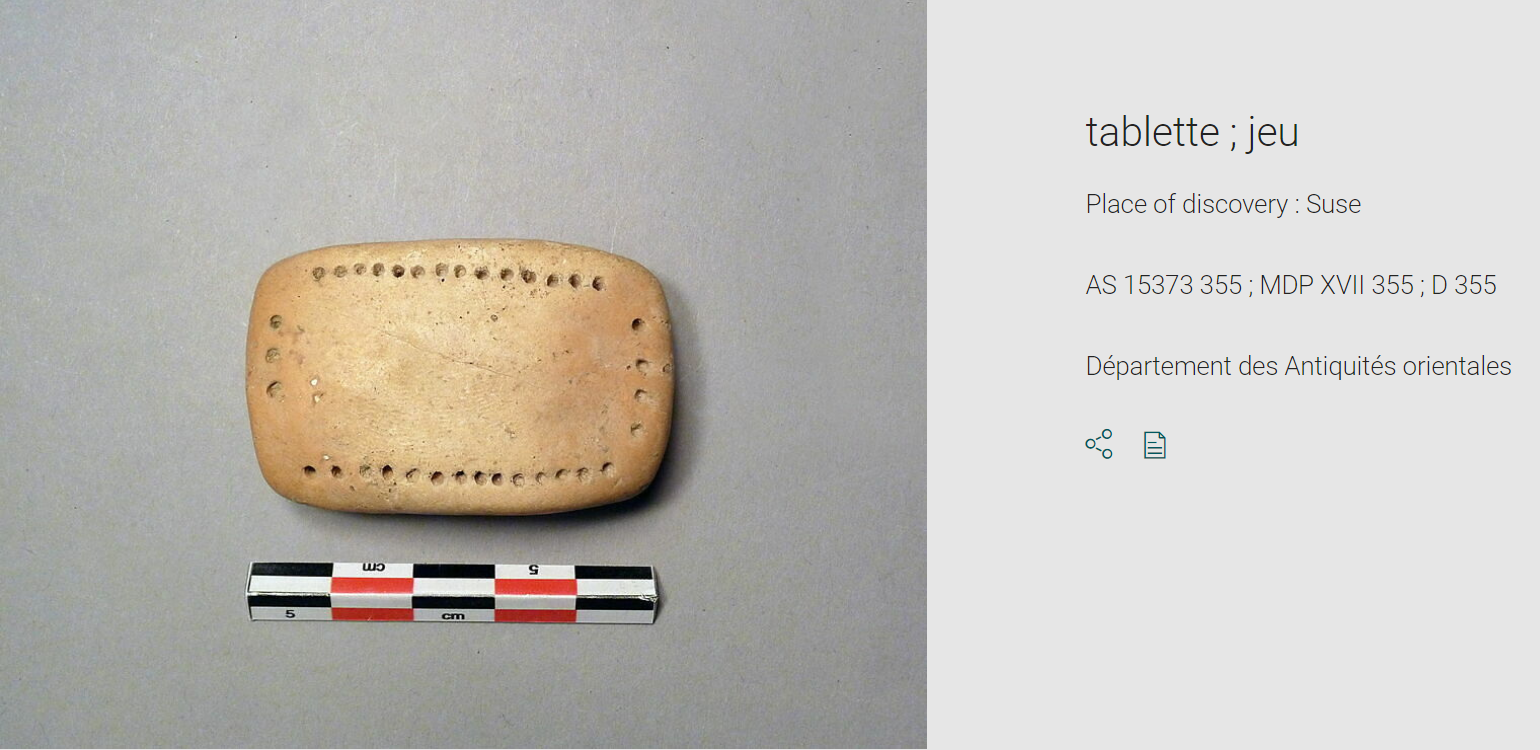
mdp 17355, https://collections.louvre.fr/en/ark:/53355/cl010198909
At a site bordering Iran and Afganistan where pE tablets were discovered, called Shahr I Sokhta, a golden prosthetic eyeball was found inside the skull of a 6 foot female buried sometime around 3000bc. It had been drilled with 8 fine holes according to geometric portioning, and through these fitted with fine wiring to fix it within the socket.
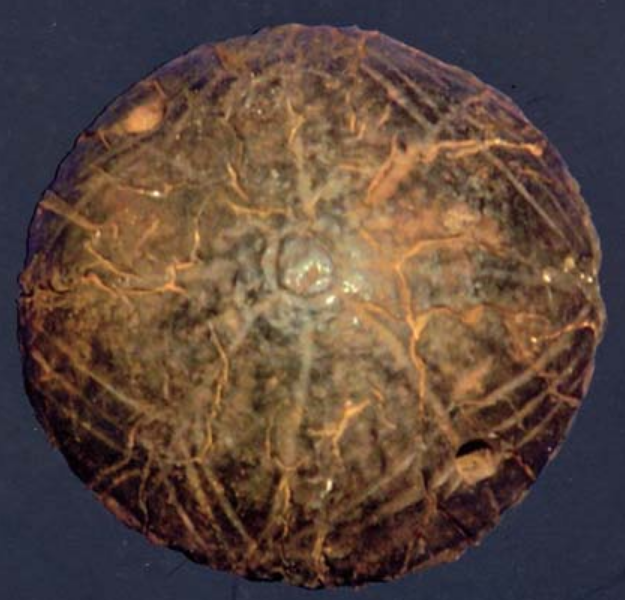
grave no. 6705, Shahr I Sokhta, 3000bc, https://shahresokhta.ir/Explain/19/Interesting_information
This sphere contains the same 8-bit portioning of the periphery to a unitary central circle, or iris, or 'inner circle', as tiled columns discovered within Gudea's temple of Ningirsu. These same 8bit columns were found in the temple district of Ur dating to the reign of Ur Dyn III.

https://collections.louvre.fr/ark:/53355/cl010163641
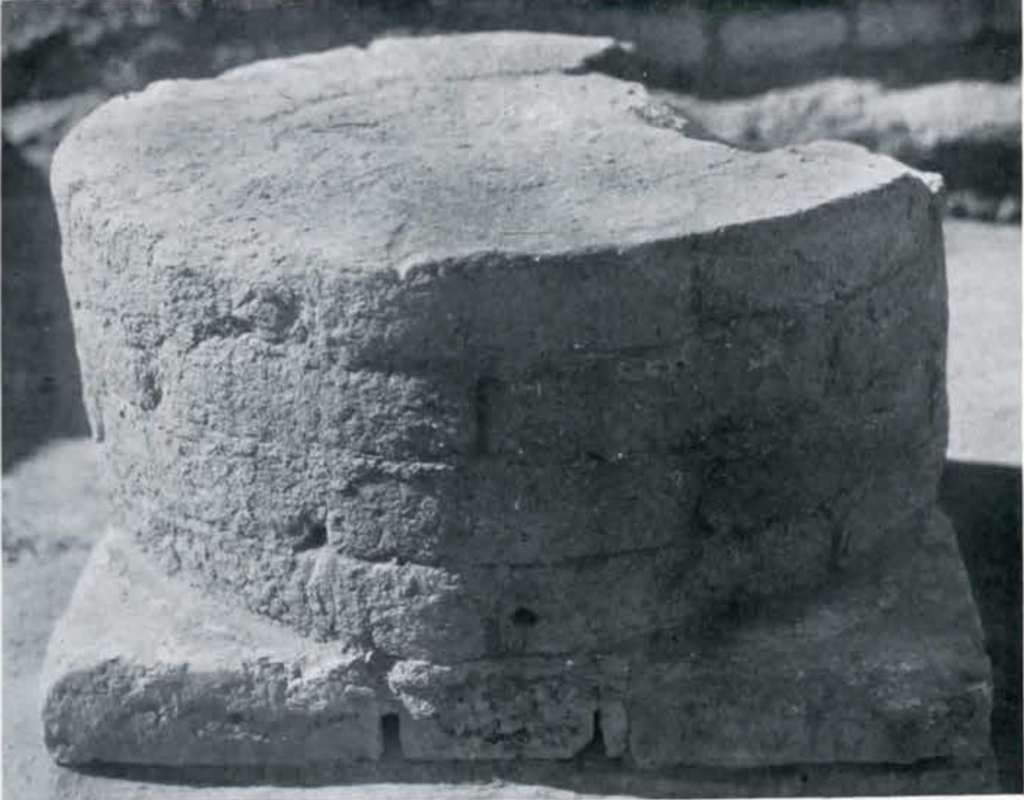
Plate VIII. Woolley: Excavations at Ur, dated 2100-2000. https://www.penn.museum/sites/journal/9272/
A gravesite at Shahr I Sokhta also contained a goblet, assuming it is genuine, painted in the first known animation. A reel of slightly adjusted pictures depicting the jumping motion of a ram.

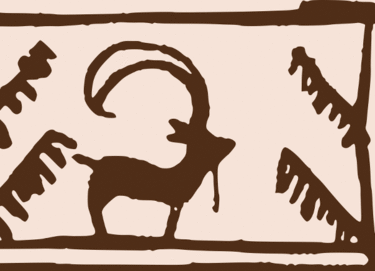
grave no. 731, Shahr I Sokhta, 3000bc
Through the 3rd millenium proto-cuneiform developed into the cuneiform writing script. It is curious though, that what appear to be cuneiform characters can be found inscribed all over about 10 tablets, seemingly excavated from level 18 of the Susun acropolis alongside the older counting artifacts, and have thus also been classified as bullae since they must date to BEFORE 3500bc. But they are not bullae. This is entirely bizarre and entirely ignored by academics, who i would imagine would attribute this to some kind of mistake. Yet, there's been no attempt, so far as I can tell, to rectify this mistake. These fucking things are just sitting there in the database as a contradiction to history. Meaning, according to the current manner in which counting and writing artifacts have been archived, Sumerian cuneiform first appears in Susun hundreds of years before its more primitive protoform appears in Mesopotamia.
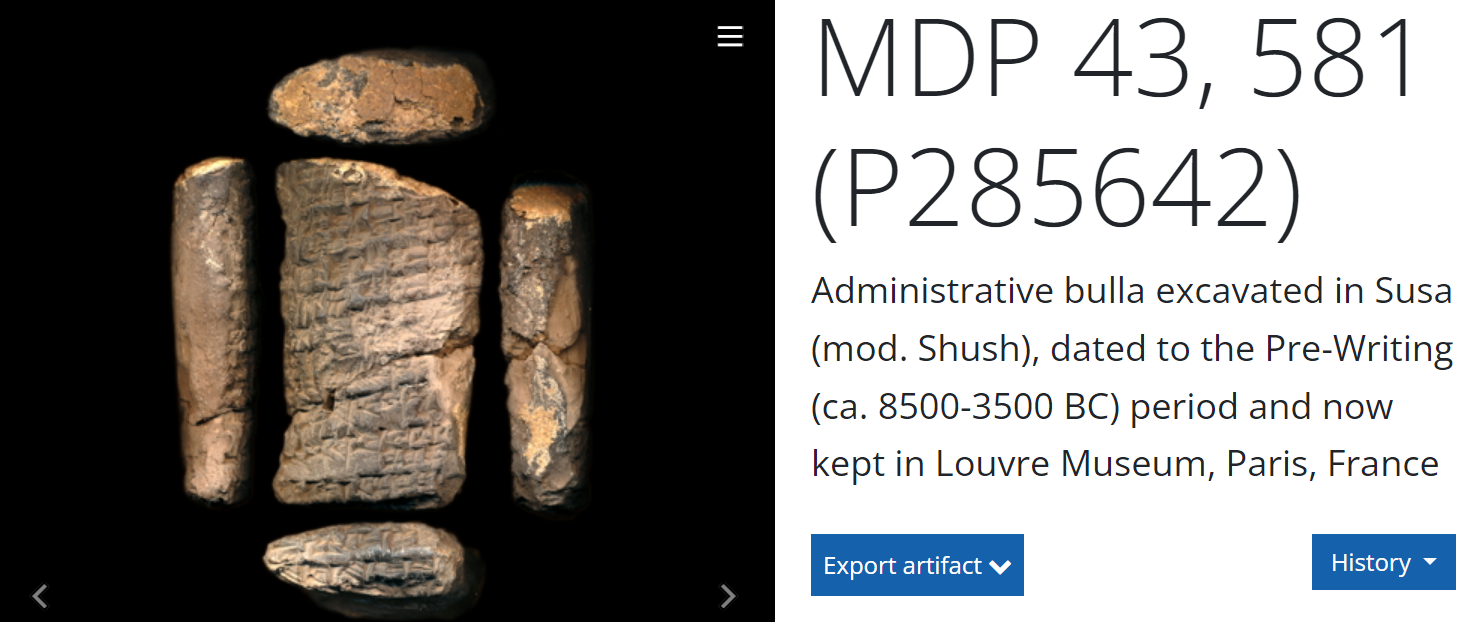
https://cdli.mpiwg-berlin.mpg.de/artifacts/285642
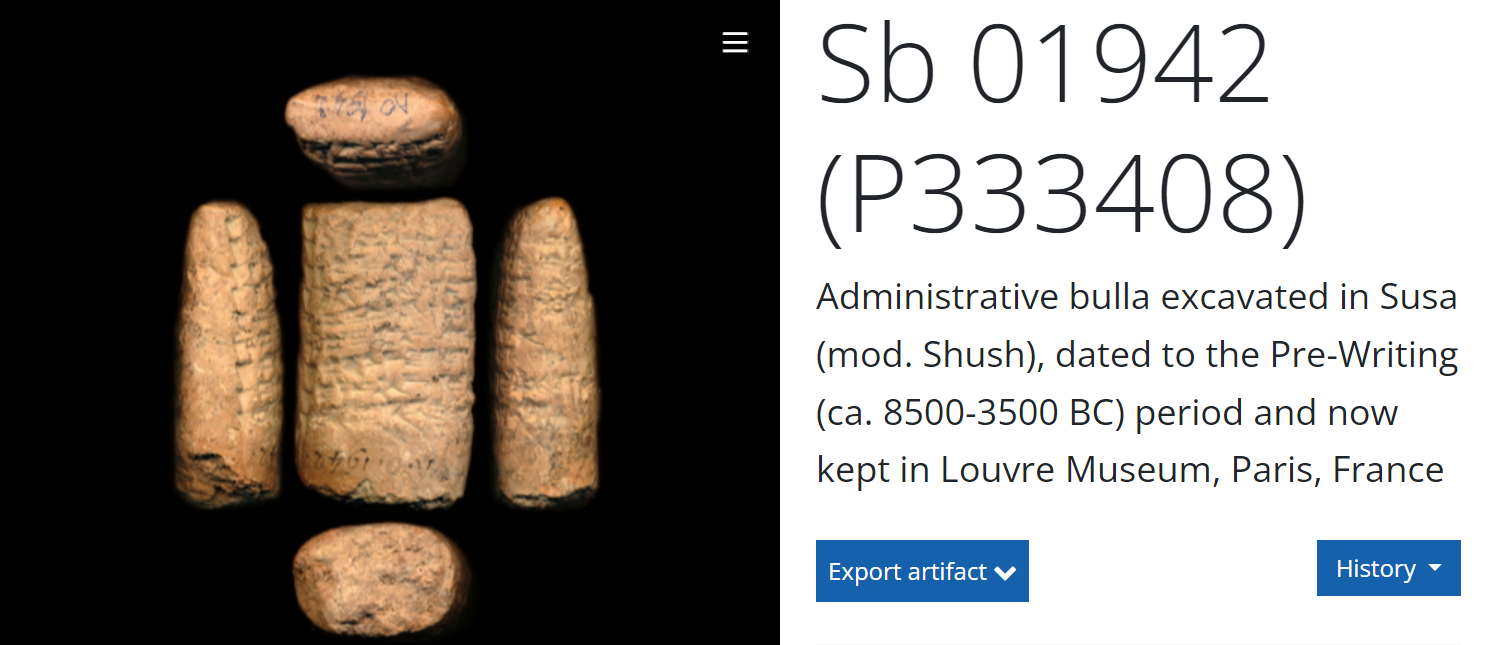
https://cdli.mpiwg-berlin.mpg.de/artifacts/333408
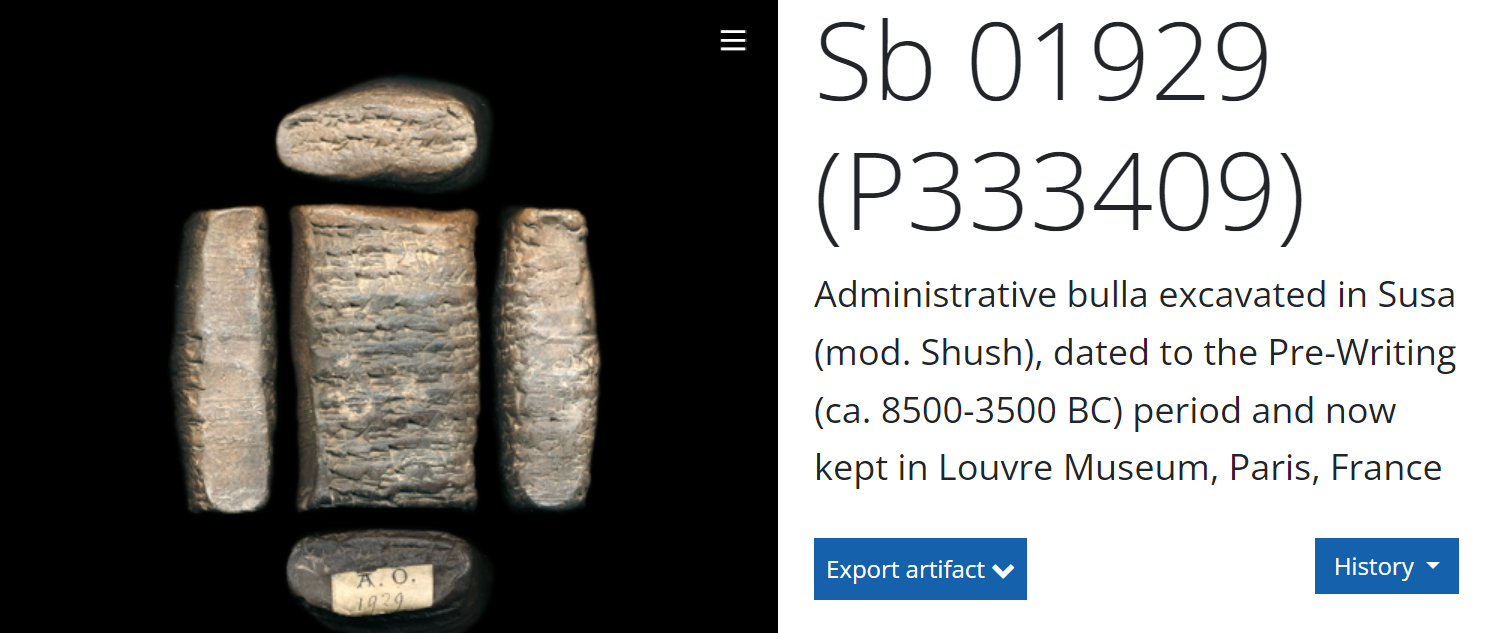
https://cdli.mpiwg-berlin.mpg.de/artifacts/333409
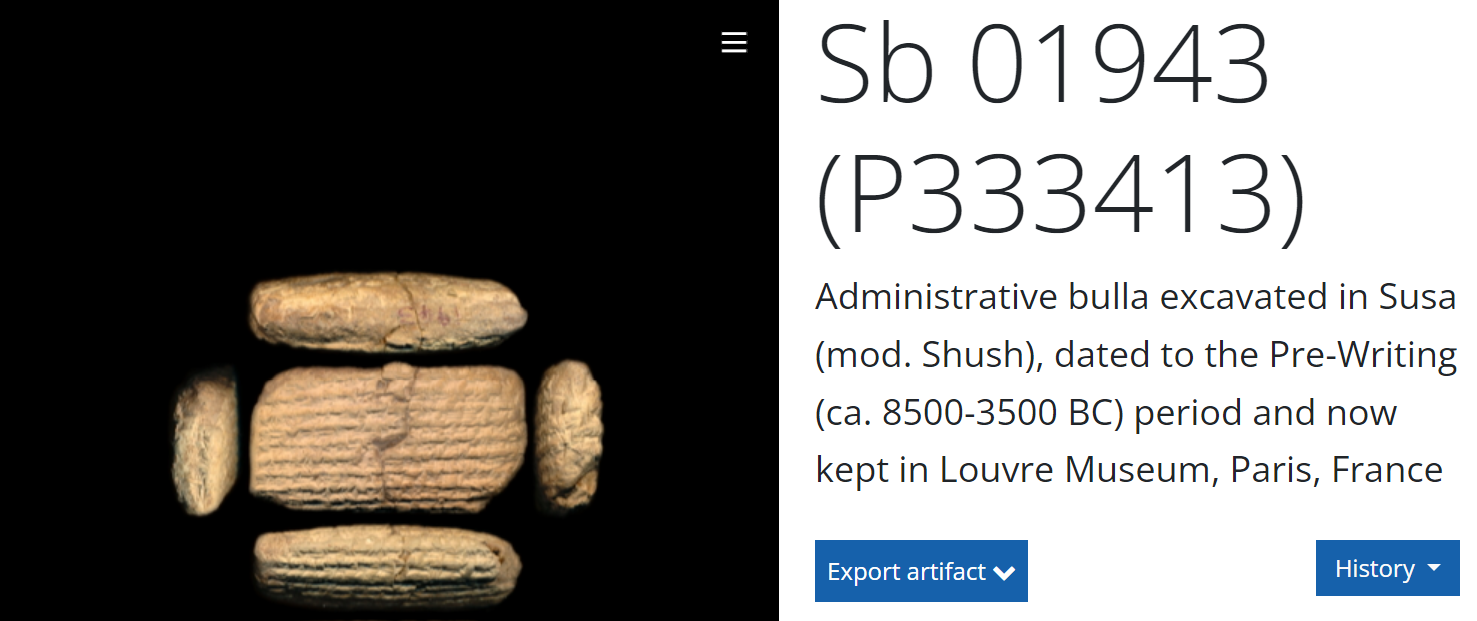
https://cdli.mpiwg-berlin.mpg.de/artifacts/333413
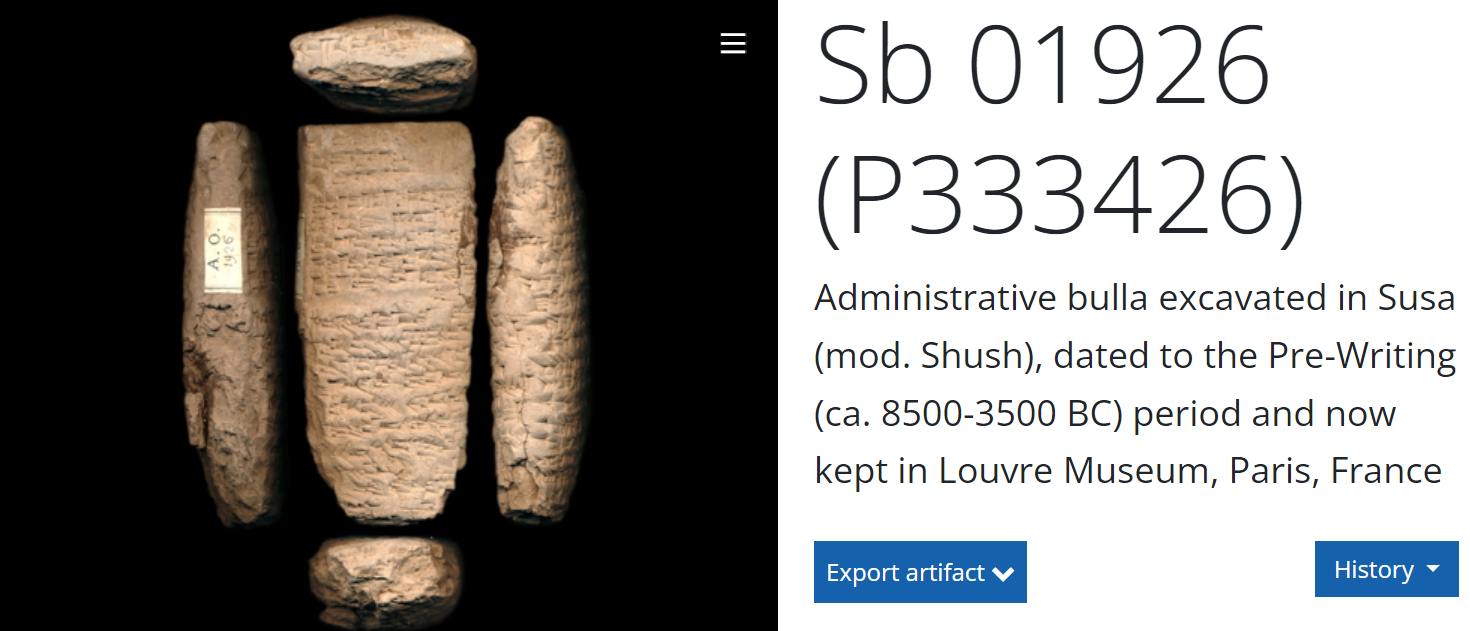
https://cdli.mpiwg-berlin.mpg.de/artifacts/333426
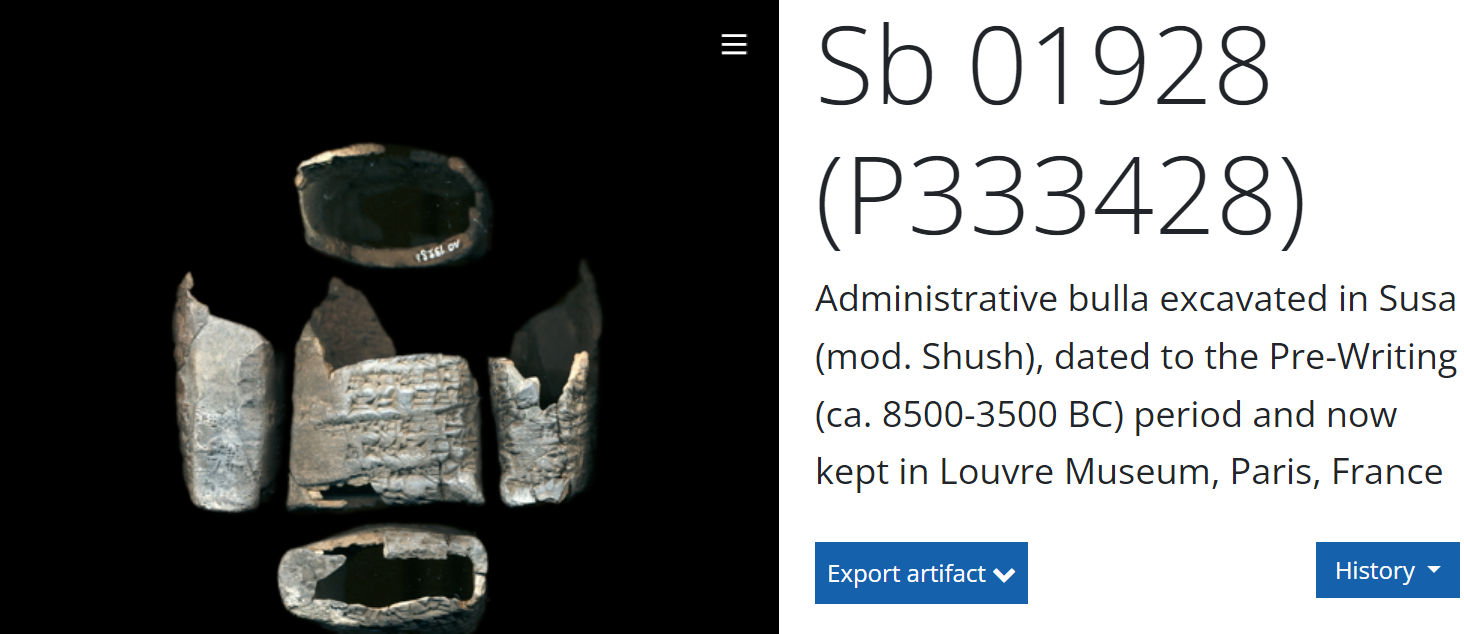
https://cdli.mpiwg-berlin.mpg.de/artifacts/333428
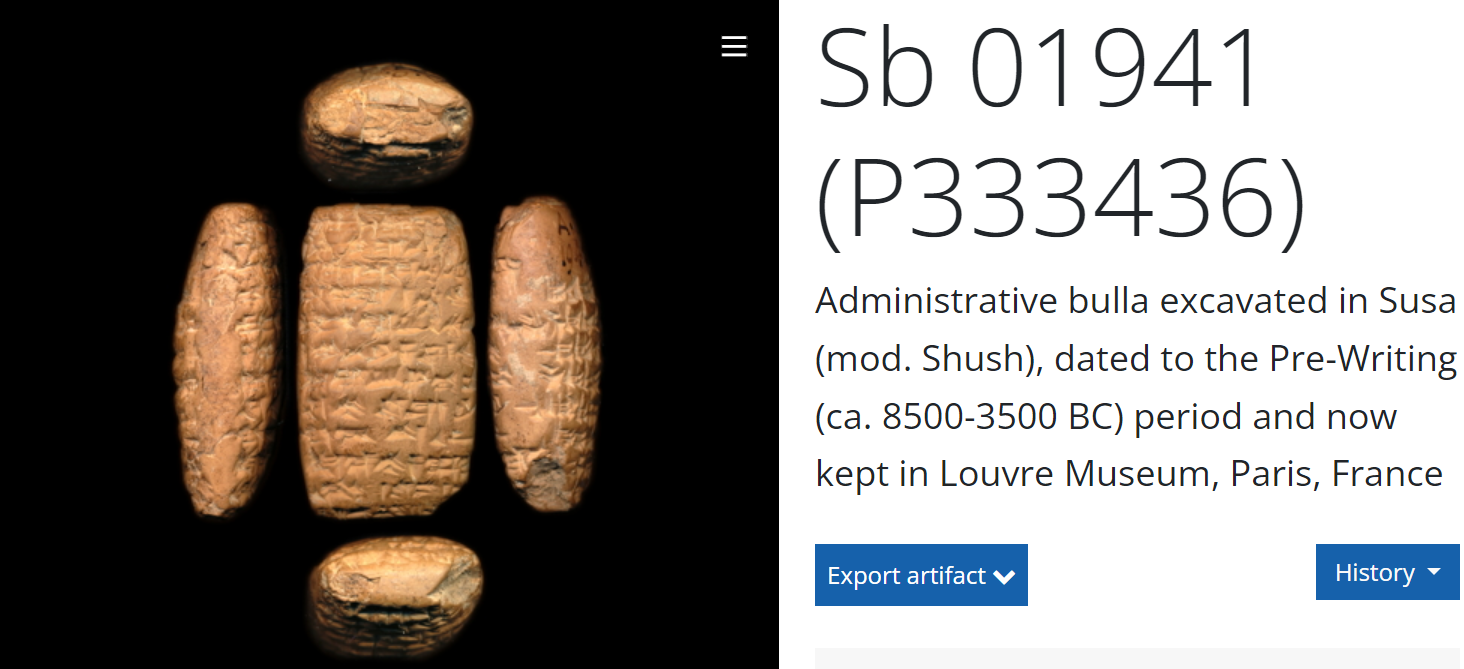
https://cdli.mpiwg-berlin.mpg.de/artifacts/333436
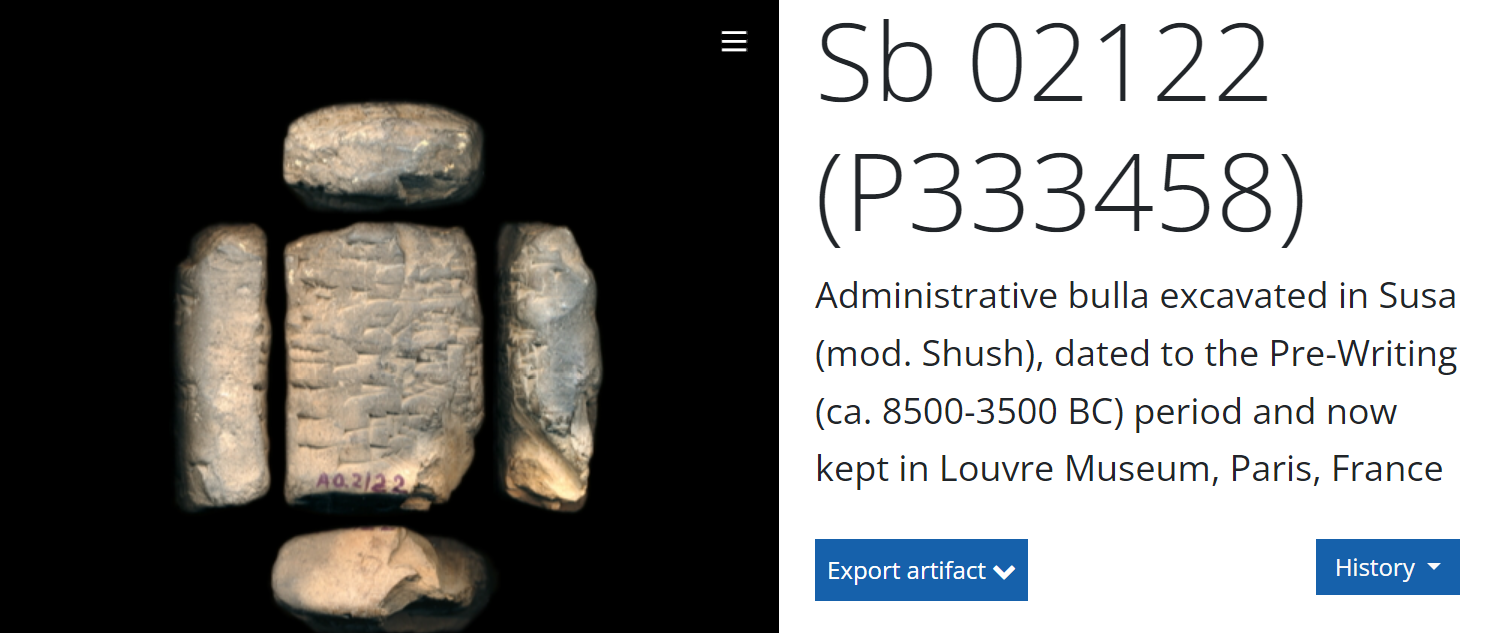
https://cdli.mpiwg-berlin.mpg.de/artifacts/333458
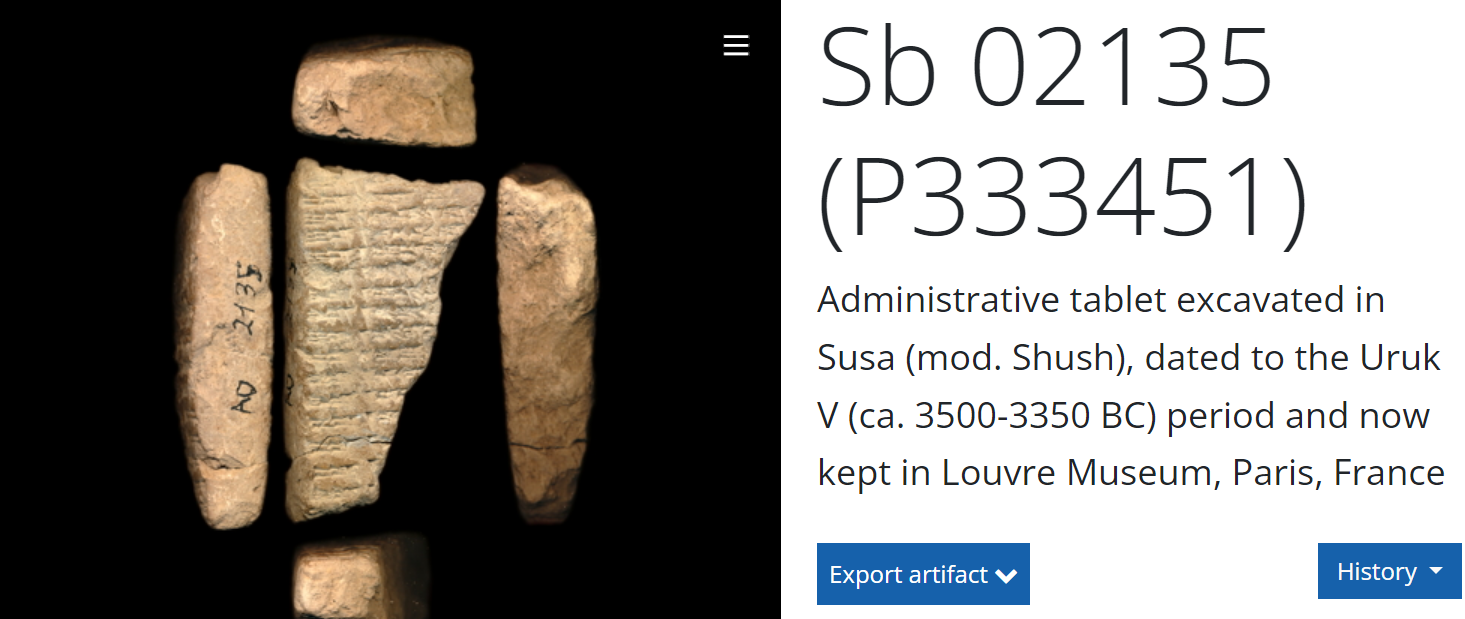
https://cdli.mpiwg-berlin.mpg.de/artifacts/333451
What happened to proto-elamite remains obscure. It kind of just disappears suddenly around 3000bc, before reappearing 700 years later in the form a purely geometric script type called linear-elamite(LE). LE was just recently deciphered in 2022, and according to its decipherers used almost entirely phonetic symbols.[8] There are currently 70 of these geometric symbols, with another 10 suspected. All of which can be formed from the 81 vertices of an 8x8 matrix grid.[9] The sample size of this geometric script is limited though, and strangely, it starts to appear in Susun around 2300bc alongside another unique script type. This varient of cuneiform used almost exclusively little horn signs to construct its symbols, and was a clear departure from the largely pictographic scripts. This has been called Old Akkadian.

Old Akkadian script begins at stage 4
This is a tablet from 2300bc that has been archived as Linear-Elamite.
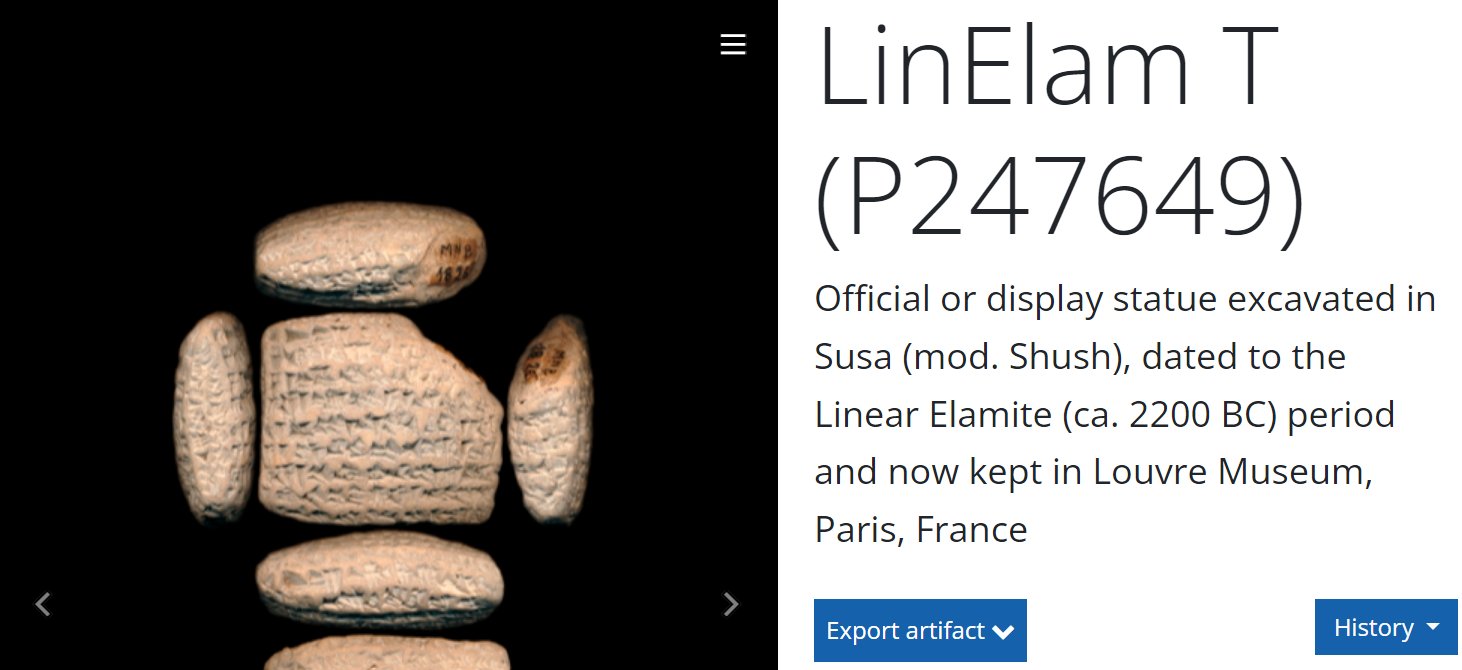
https://cdli.mpiwg-berlin.mpg.de/artifacts/247649
These are tablets from 2300bc that have been archived as old Akkadian.
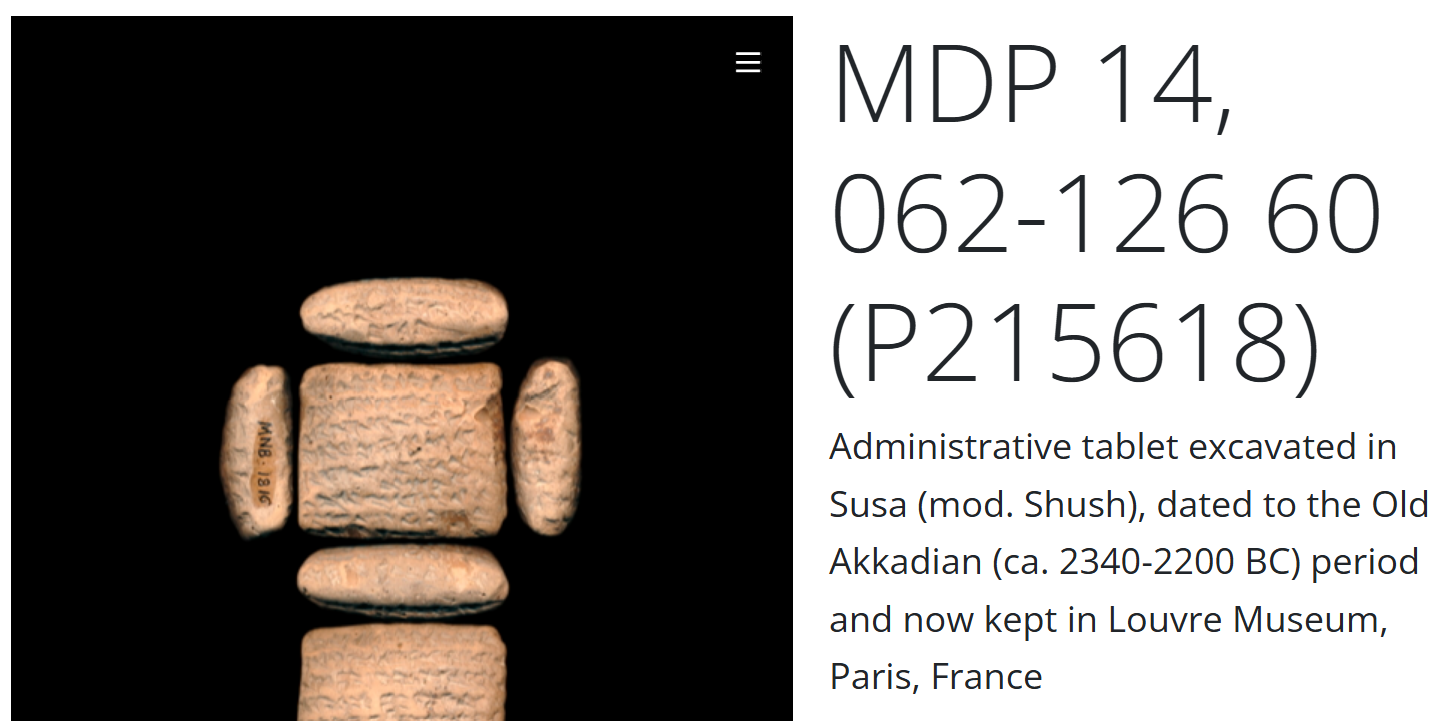
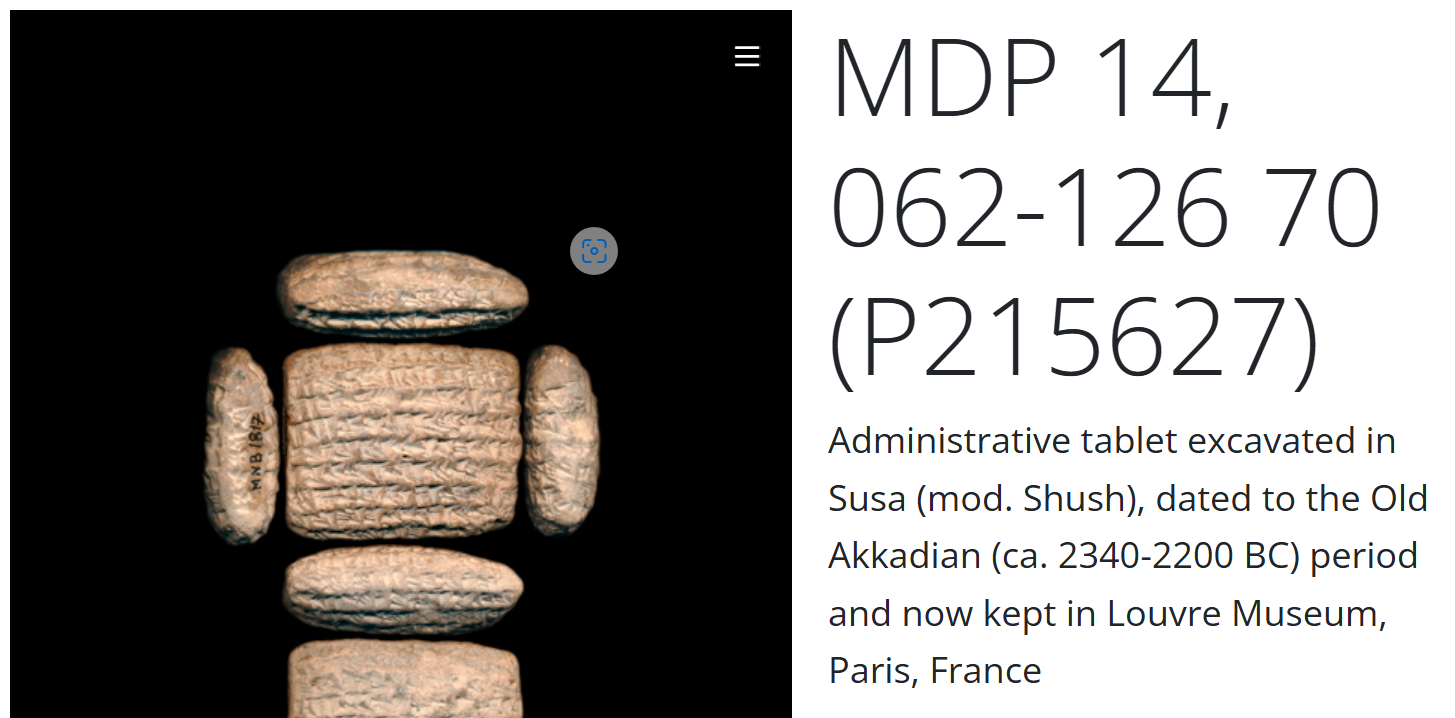
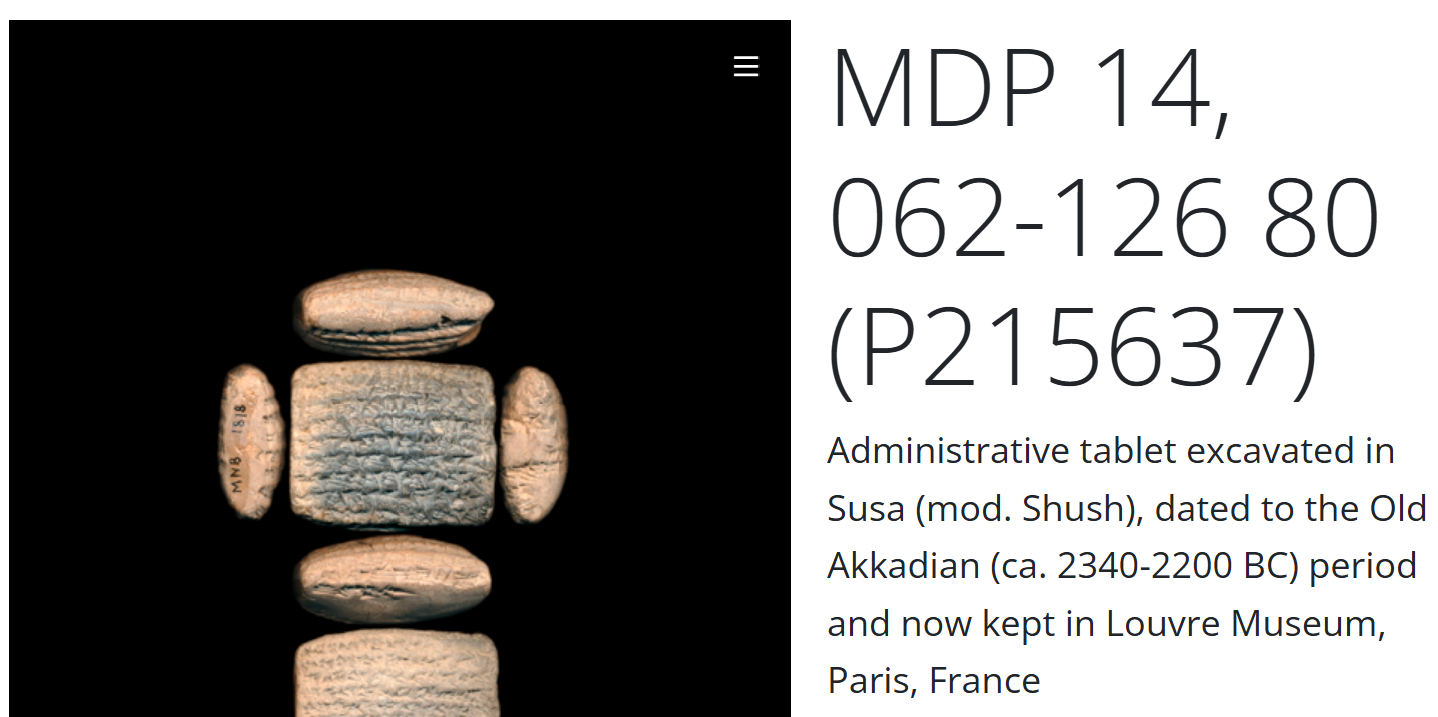
Compare these with the ones from Susun archived away in the pre-writing period. None of it adds up.
Their history is a house of cards. So now they need to go into Iran.
Anyhow, in the token system, tetrahedrons were used to symbolize labor. The hatamti used the decimal system to count livestock and workers, and used the sexagesimal system for commodities like grain, used to pay rations. So workers counted in the decimal system were rationed grain/cereal counted in the sexagesimal one, and the relation between them as wages, was symbolized as a ratio by a tetrahedron.
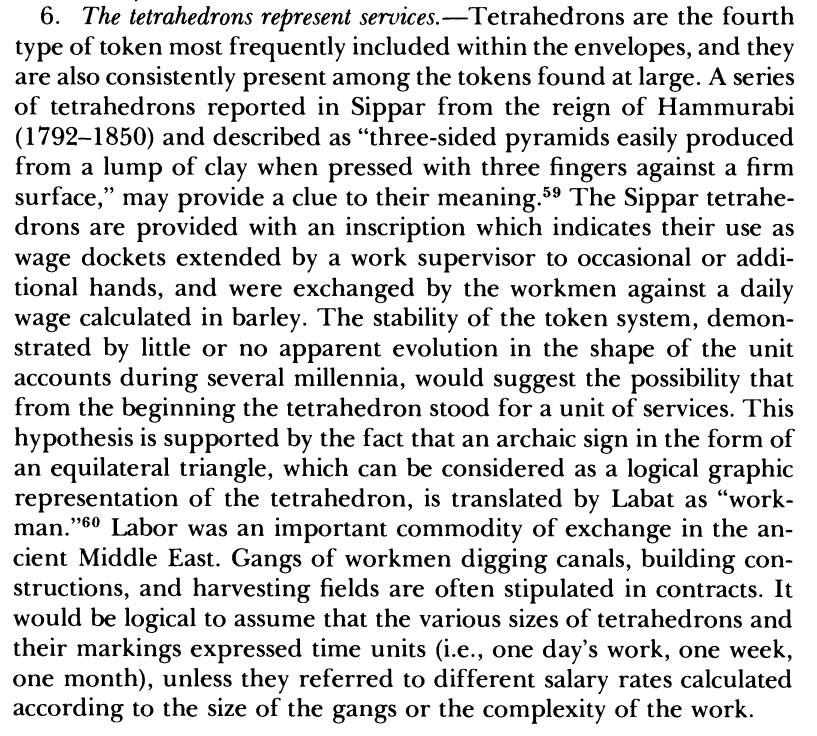
The Envelopes That Bear the First Writing, Denise Schmandt-Besserat, Source: Technology and Culture, Vol. 21, No. 3 (Jul., 1980), pp. 357-385
Imagine labor as line dimensions, working its way around four vertices of a square to create surface, then up from these to meet in a fifth to create the volume of a geometric tetrahedron. As the tetrahedron grows bigger, the ratio of exchange, or labor value for you marxists, between its line dimensions and volume gets smaller.
This is not a numeric system. This is a geometric system.
“For party strife is everywhere due to inequality, where classes that are unequal do not receive a share of power in proportion (for a lifelong monarchy is an unequal feature when it exists among equals); for generally the motive for factious strife is the desire for equality. But equality is of two kinds, numerical equality and equality according to worth—by numerically equal I mean that which is the same and equal in number or dimension, by equal according to worth that which is equal by proportion4; for instance numerically 3 exceeds 2 and 2 exceeds 1 by an equal amount, but by proportion 4 exceeds 2 and 2 exceeds 1 equally, since 2 and 1 are equal parts of 4 and 2, both being halves”
- aristotle, politics, 1301a [19]
“For Lycurgus, I suppose you know, banished out of Sparta all arithmetical proportion, as being democratical and favoring the crowd; -but introduced the geometrical, as [p. 404] agreeable to an oligarchy and kingly government that rules by law; for the former gives an equal share to every one according to number, but the other gives according to the proportion of the deserts.”
- plutarch, quaestiones convivales conv 8.2.2
This is the true succession.
[0]Archaic bookkeeping: early writing and techniques of economic administration in the ancient near east, Hans j nissen, Robert Englund, Peter Damerow, University of Chicago 1993
[1] There’s good reason for the requisite of writing for civilisation. A complex society without writing cannot speak for itself historically. Which leaves it vulnerable to politically motivated academics, usually anarchists, who seek to legitimize ideological beliefs by projecting these onto complex yet mute societies in pre-history, whose sophistication in other regards can be pointed to as reasons for removing the requisite of writing from civilization, which is of course, the only thing preventing them from molesting the historical record with contemporary ideology.
[2] 'Absolute Chronology of the Uruk and Jemdet Nasr Periods in Uruk, Southern Mesopotamia. The Interpretation of Additional 14C Samples, Zeitschrift für Orient-Archäologie 8', 2015, 10–37, Margarete van Ess, 2015
[3] 'Proto-Elamite Writing in Iran', Francois Desset, 2016.
[4] 'The Uruk Expansion Cross-cultural Exchange in Early Mesopotamian Civilization' by Guillermo Algaze, 1989
[5] SUSE, CHANTIER "ACROPOLE 1", Alain LE BRUN, Source: Paléorient, Vol. 4 (1978), pp. 177-192
[6] Desset François. Proto-Elamite Writing in Iran. In: Archéo-Nil. Revue de la société pour l'étude des cultures prépharaoniques de la vallée du Nil, n°26, 2016. Naissance de l'état, naissance de l’administration : le rôle de l'écriture en Égypte, au Proche-Orient et en Chine / Emergence of the state and development of the administration: the role of writing in Egypt, Near East and China. pp. 67-104;
[7] 'The Chronological Division of the Archaic Levels of Uruk-Eanna VI to III/II: Past and Present, Eva Strommenger, Source: American Journal of Archaeology, Vol. 84, No. 4 (Oct., 1980), pp. 479-487
[8] The Decipherment of Linear Elamite Writing, 2022, Francois Desset, Kambiz Tabibzadeh, Matthieu Kervran, Gian Pietro Basello and Gianni Marchesi)
[9] Ancient Geometry: Writing Systems, Art, Mathematics, Azhideh Moqaddam (Tehran University)